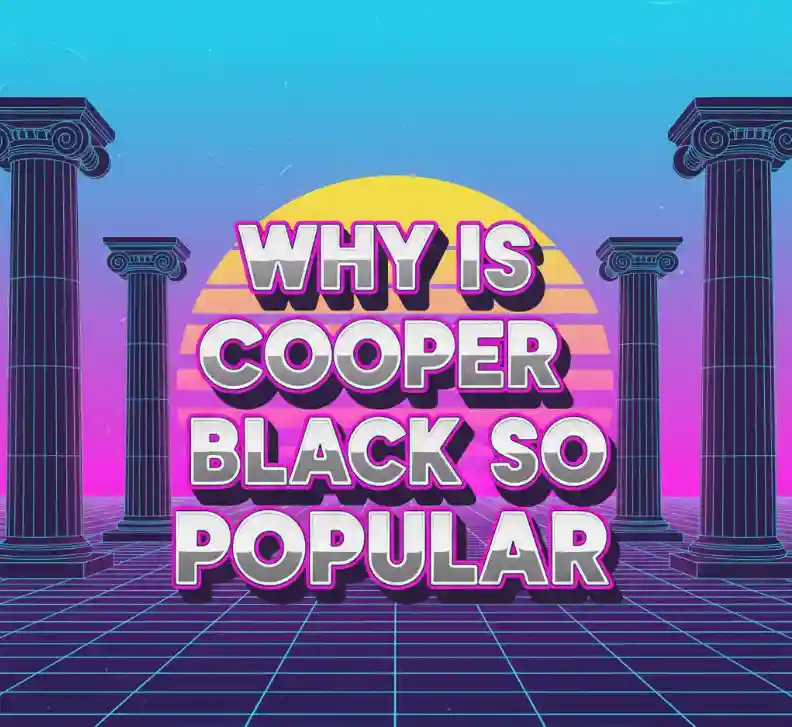Table of Contents
- Introduction
- A brief history of Cooper Black
- Key reasons for its popularity
3.1 Legibility and display-friendly form
3.2 Cultural and pop-culture momentum
3.3 Retro aesthetic & revival in modern design
3.4 Adaptability in branding and advertising - What designers can learn from its success
- How your own fonts (from RaisProject) can tap similar strengths
- Conclusion
- References

1. Introduction
If you’ve ever glanced at an album cover, a café sign, or a t-shirt slogan and thought “this typeface looks familiar,” chances are you’ve seen Cooper Black. Designed more than a century ago, this bold, friendly serif somehow refuses to fade from view. That begs the question: why is Cooper Black so popular?
In this article, we’ll unpack its origins, discover what keeps it relevant today, and reveal what lessons type designers—and fans of distinctive fonts—can draw from it. You’ll also find examples of handcrafted display fonts from RaisProject that carry on Cooper Black’s legacy in fresh, modern ways.
2. A brief history of Cooper Black
Cooper Black was designed by Oswald Bruce Cooper and released by Barnhart Brothers & Spindler in 1922 as part of the Cooper Old Style family (Wikipedia).
Its thick, soft serifs and exaggerated curves made it stand out in an era obsessed with legibility and optimism after World War I. The foundry even promoted it as “for far-sighted printers with near-sighted customers” (Typeroom).
During the 1960s and 1970s, Cooper Black exploded into pop culture—appearing on album covers like Pet Sounds by The Beach Boys and on advertising billboards across America (Newberry Library). By the time digital design arrived, the typeface had already cemented its status as a global favorite.
3. Key reasons for its popularity
3.1 Legibility and display-friendly form
Cooper Black’s exaggerated weight and soft, rounded serifs make it highly legible even at large sizes or in low-contrast printing conditions (Print Museum). The letterforms maintain personality while remaining clear and easy to read — a balance every display font should strive for.
Design scholars note that it “doesn’t need to be laid in a straight line to look good” (Toronto Metropolitan University PDF), a testament to its organic, friendly structure.
3.2 Cultural and pop-culture momentum
Few fonts have crossed into pop culture as deeply as Cooper Black. Its retro-friendly curves fit the psychedelic vibe of the 1960s and 70s, appearing on album art, film titles and posters (Open Culture).
When a typeface becomes a cultural touchstone, its popularity feeds on itself: brands and designers reuse it to tap into its emotional nostalgia.
3.3 Retro aesthetic & revival in modern design
Cooper Black fits perfectly into the ongoing retro and mid-century revival trend. Its chunky form communicates warmth and friendliness—qualities that digital brands crave today to stand out from minimalist sans-serif competitors (Letterhend Studio).
Modern designers rediscover it as a way to signal authenticity and fun, proving that a hundred-year-old font can still feel modern.
3.4 Adaptability in branding and advertising
From coffee shops to music festivals, Cooper Black thrives where you need impact and memorability. Its thick strokes hold up in both print and digital media, making it a go-to for logos and headline work.
The key lesson for modern font creators: design for cross-platform versatility. A typeface that reads well on a billboard and a mobile screen is far more likely to spread organically.

4. What designers can learn from its success
- Prioritize readability. Even ultra-bold display fonts must retain clarity.
- Give your font a distinct personality. Rounded edges or playful details can evoke emotion.
- Design for multiple contexts. Ensure your typeface scales well from print to web.
- Leverage cultural resonance. Fonts that connect to shared memories create instant appeal.
- Offer flexibility. Provide alternates or weights to broaden use cases.
5. How your own fonts (from RaisProject) can tap similar strengths
At RaisProject Studio, you already curate a rich library of display typefaces that mirror the strength and friendliness of Cooper Black. Here are a few that embody similar energy and impact:
When promoting these fonts, mention that they are “inspired by the timeless boldness and friendly curves of Cooper Black.” That connection instantly positions your work within a trusted typographic heritage.
6. Conclusion
So—why is Cooper Black so popular? Because it embodies the perfect blend of readability, personality, and cultural memory. It’s bold but not loud, friendly but confident. It bridges eras and mediums without losing its charm.
For modern font designers, its journey is a blueprint for longevity: build a font that works hard, communicates emotion, and adapts across trends.
To see how those principles live on today, browse the handcrafted typefaces at RaisProject.com — where classic inspiration meets contemporary craftsmanship.

7. References
- “Why This Font Is Everywhere: The Rise of Popular Typography.” Letterhend Studio
- “Cooper Black.” Wikipedia
- “Cooper: Origins, Legacy and Iconic Moments.” Typeroom
- “Why This Font Is Everywhere: How Cooper Black Became Pop Culture’s Favorite Font.” Open Culture
- “Wood Type: Cooper Black.” International Printing Museum
- “Cooper Black Turns 100.” Newberry Library
